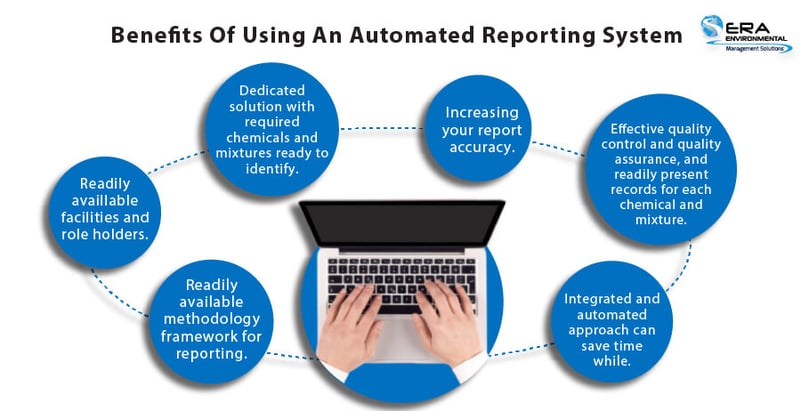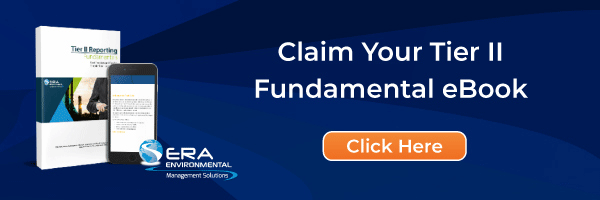 Tier II reporting is used by the EPA to track and enforce rules related to the storing of hazardous materials in your facility. Housing hazardous chemicals in your facility can pose an immense risk to your workers, the environment, and surrounding communities. It is essential to track all your hazardous chemicals and to know their specific quantity and location to ensure the safety of these surrounding communities and meet their community right to know. This article will give you everything you need to know about Tier II reporting requirements, who should report, and what you should report, and other information about Tier II reporting.
Tier II reporting is used by the EPA to track and enforce rules related to the storing of hazardous materials in your facility. Housing hazardous chemicals in your facility can pose an immense risk to your workers, the environment, and surrounding communities. It is essential to track all your hazardous chemicals and to know their specific quantity and location to ensure the safety of these surrounding communities and meet their community right to know. This article will give you everything you need to know about Tier II reporting requirements, who should report, and what you should report, and other information about Tier II reporting.
What is Tier II Reporting?
Tier II is an annual federal report that is mandatory for companies that store hazardous materials. After a series of hazardous waste releases that caused human and environmental harm, there was a great need for reporting on hazardous materials that are housed within industrial facilities. This led to Emergency Planning and Community Right-to-Know Act (EPCRA) being passed in 1986. The EPCRA group of regulations includes:
- Emergency planning (Sections 301-303).
- Emergency release notification (Section 304).
- Hazardous Chemical Storage Reporting Requirements (Sections 311-312).
- Toxic Chemical Release Inventory (Section 313).
- Tier II (SARA 312).
Tier II (SARA 312) is under section 312 of EPCRA and it is a mandatory report of hazardous and toxic substances that are housed at your facility at any given point during the reporting year. Facilities are required to report Tier II substances and Extremely Hazardous Substances (EHS) that are equal to or greater than the defined Tier II reporting thresholds. These substances must maintain an SDS under OSHA’s hazard communication standard.
Who Should File a Tier II Report?
Facilities that store hazardous chemicals must report their inventory in the Tier II report. Let us break down the reporting requirements.
You must submit a report if:
- A facility has greater than or equal to 10000 pounds of any hazardous chemical by OSHA criteria, then it should be reported in the Tier II report.
- A facility at any given time during the reporting year stored material on the EPA Extremely Hazardous Substance list to the materials’ defined Threshold planning Quantity (TPQ). The EPA has a comprehensive EHS list that shows all the chemicals that should be reported.
- You have reached the threshold for gasoline storage which is 75000 gallons and 100000 gallons for diesel fuel at a retail gas station. This threshold applies if there was entire underground storage and full compliance with the Underground Storage Tank (UST) requirements.
- Your Local Emergency Planning Committee (LEPC) needs, you to submit an SDS for Hazardous chemical if your LEPC and State Emergency Response Commission (SERC) or fire department asks you to submit Tier II then the threshold level for reporting is zero.
Remember that some states have stricter reporting requirements and thresholds, therefore you should make sure that you stay up to date with your specific state reporting requirements.
What Should You Report for Tier II?
You must report the inventory information for quantities of hazardous chemicals that were housed at your facility at any time during the reporting year that are greater than or equal to the threshold. All states require Tier II submission, and it is mandatory for all facilities. All substances and chemicals that require an SDS must be recorded. Do not be selective, record all the chemicals, that way you will have a full inventory list when you start generating your report.
Once you have the full list of your chemicals, consult the Tier II chemical list for which ones must be reported. Of these chemicals, the aspects that should be listed in a Tier II report are listed below:
- Physical and Health Hazards of each reportable chemical (all applicable).
- Maximum Amount on Site (in pounds).
- Average Daily Amount on Site (in pounds).
- The number of days chemical/mixture was present on-site (i.e., 365 days).
- Storage Types, Conditions, and Locations.
.jpg?width=412&name=What-Should-You-Report-for-Tier-II-copy-ERA-Environmental%20(1).jpg)
You must describe the specific location of the chemical to help emergency responders to access it quickly and clearly show the building or room in which it is stored. It is helpful to provide a comprehensive site map for the chemical(s). If you would like to claim any confidential locations, you must submit your confidential location information with your Tier II report if available.
Reporting Methods
When you are tracking your hazardous chemicals, there are various ways of reporting them. This can be done by tracking:
- Standing inventory - take note of the inventory in your facility, don't forget to take note of the expired materials.
- Usage patterns - track how much material that you are using but remember usage does not directly equate to the amount that you have on-site. Therefore, it should be used as a factor among the other tracking methods.
- Monthly purchase records - this is a good way of tracking what products are on-site each month and can contribute to the usage records.
- Monthly inventory - Tracking your inventory monthly will make it easier to show when you had the hazardous chemical and how long it was on site.
- Combination - the best way of effectively making the calculation is to combine all the tracking methods mentioned above and using a software solution can make this process effortless.
With this information, you can use three different methodologies:
Method one - Uses standing inventory to give snapshots of chemicals on-site at a given time.
Method two - Daily/monthly calculated inventory, this combines purchase records and usage records.
Method three – This is when you use the best available information for tracking. If your site does not maintain inventory records, you calculate the maximum onsite as an approximation of usage. Also, consider if the chemicals are purchased in bulk and how long it takes to use the purchased products. You can use these amounts to calculate maximums by usage summation.
What about chemical analysis and mixture analysis for Tier II Reporting? Reporting mixtures can be a tricky situation but it is easily handled by knowing the reportable chemicals in the mixture. You have the option to either report the entire mixture or the portion of the mixture that is hazardous. You must combine the amount of EHS for effective threshold determination. Make sure that the option that you choose for each mixture is consistent with the one used in your report.
Tier II Reporting: Timeline and Steps
The steps to Tier II reporting start from effective record keeping. You must keep all your inventory, usage, and storage information ready for reporting. The next step would be to create a Tier II project to start organizing all your Tier II information. The process also includes selecting a processing method based on the methods mentioned above. After adding all the reportable chemicals’ quantities and details comes the review step. This is when you review all the chemicals that you have entered individually to make sure you have included everything accurately. Double check the maximum and average quantities on sight. After the review process, you are now ready to submit your Tier II report through the software of your choice.

ERA’s Tier II Report gives you the possibility to create Tier II projects for reporting. This software solution also provides accurate calculation and threshold determinations based on usage, inventory or chemicals, products, or categories.
Using information from previous years, product specifications in the system or both cumulated data from both reporting hazard classifications and storage locations for a reportable product. You can also preview report results before submitting the report with enough flexibility to finalize and update or change the data that is entered and generate a hard copy of the report for your reference.
Tier II Reporting Exemptions
Several chemicals are exempt from Tier II reporting. Substances that are solid and don’t cause any exposure during normal use are often exempt from reporting. However, take special note for items that seemingly fit this description but are in fact regulated - for example lead-acid batteries are solid during normal use, but OSHA has determined that they are not exempt because they have the potential to leak, spill, or break during everyday use. Other exempt materials include substances used in research laboratory hospitals, and routine agricultural operations. More exemptions and guidelines are listed in the diagram below.
.jpg?width=605&name=Tier-II-Reporting-Exemptions-ERA-Environmental%20(1).jpg)
When is The Tier II Reporting Deadline?
The Tier II report is due on March 1st every year.
- This is a fixed deadline, and the EPA does not grant extensions to this deadline.
- Tier II forms should be submitted to your SERC, LEPC, and local fire department before March 1st.
- Failure to submit your Tier II Report is a Emergency Preparedness/Right-to-Know violation and is subject to fines and penalties.
Tier II Penalties and Fines
There are many fines associated with the incorrect filing or filing of your Tier II forms late. The penalties are assessed based on the nature, extent, gravity, and circumstances of the violation.
The penalties for this can be up to US$50,000, therefore you must ensure that you file your Tier II on time and with all the right information. For example:
- A late submission penalty of between 10 and 30 days can rack up fines up to US$12,000 and a minimum of $25,000 after a 30-day delay.
- Missing a chemical can have a hefty penalty. For example, a food and beverage company failed to submit their Tier II for one chemical, anhydrous ammonia, for four years. The company had to pay a penalty of US$65,710 for missing that one chemical in their report over the reporting years.
- Failure to submit the report for any chemical at your facility is also subject to penalty. For example, a fertilizer company failed to file a Tier II for 26 hazardous chemicals at their facility for two years and had to pay a penalty of US$62,985.
Using the Tier II EPA Online Reporting Platforms
Using online reporting Tier II software is the most effective way of submitting your Tier II report. The two main software used are Tier2 Submit and E-plan.
Tier2 Submit must be downloaded each year for effective reporting and E-plan system that allows you to create and file your Tier II easily. The EPA provides a detailed PowerPoint tutorial on how to fill in the Tier2 Submit form effectively.
Some states have specific online filing systems so make sure you check which system is used in your state.
ERA's Tier II Reporting Software can be used to generate a report which can be uploaded to nearly any of these EPA and State Reporting Platforms.
Tier II Report Best Practices
With the wealth of information that you have acquired already, it is still essential to make sure that your account for everything when you are filing your Tier II report. ERA has some best practices that you can use when you are preparing for your tier II report:
- Keep records for all the chemicals that require SDS on your facility to ensure that you have sufficient information when the reporting time comes. Also consider doing your Tier II report by SDS/Mixture because this more clearly identifies the storage location for the product.
- If you choose to group chemicals, we recommend that you ensure that they are grouped based on the same physical and health hazards.
- For oil and gas, drilling fluids may contain EHS such as hydrofluoric acid, therefore you should take note of this in your report. If your facility produces more than 10000 pounds of natural gas condensate, then you must report the hazardous substance.
- Make sure that you select the most appropriate reporting method for your facility that is comprehensive for first responders.
- GHS Physical and Health hazards are required to be specified on a Tier II report. Remember, any material that has an SDS is considered when evaluating if reporting is required.
- Use an automated reporting system to minimize errors in your reporting. This has several benefits shown in the diagram below.

Common Tier II Report Mistakes
When you are filing your Tier II report, you must be careful not to forget reporting for commonly missed items. For example, for storage tanks, you must note the capacity of your storage tank and what material is stored in the tank, remember to note multiple materials were stored in the tank during the year, then they should all be reported. Use the tank capacity to calculate the maximum amount.
Batteries are frequently missed when filing a report. They should be reported when they contain EHS or HS. Lead-acid batteries are hazardous chemicals under OSHA because of their associated chemical and physical hazards. They have the potential to emit hydrogen gas which is highly flammable. Most batteries also have sulfuric acid. The TPQ for sulfuric acid is 1000 pounds and the facility should report sulfuric acid if the amount in all the batteries is above 500 pounds.
Other commonly missed items are pressurized gas tanks and wood dust.
A special reporting situation that may arise is if your company would like to report a chemical that is part of a Trade Secret. The EPA gives special permission to withhold information about that chemical, but you must fill out a trade secret claim package with Trade Secret Substantiation Form (EPA Form 9510-1). You must also send a sanitized and un-sanitized version of your Tier II report to the EPA.
There are further details on common Tier II reporting mistakes in ERA’s 5 Tips for More Effective Tier II Reporting blog article.
To Complete the Tier II Knowledge Session, Here Are ERA’s Do’s and Don’ts.
Do:
- Use online submission tools such as e-plan or Tier2 Submit. An added advantage is that if you have previously submitted using these platforms, it will make your reporting easier because previous facility records are retained in the system.
- Make sure you record the units of measurement for hazardous chemical quantities in pounds (lbs.).
- Remember to check your state-specific submission requirements, since some states have stricter reporting requirements than others.
- Download the current year's version of Tier2 Submit. It should be redownloaded every year because there are constant bug fixes and updates.
Do not:
- Leave your reporting until the last minute, tracking should be done throughout the year and reporting preparation well in advance to avoid being rushed or submitting a rushed report.
- Overreport or include information that is not required, check your thresholds and the EHS list thoroughly when you are formulating your reports.
- Submit without Tier2 Submit verification.
In conclusion, filing your Tier II report can be very easy if you take time to effectively track your chemical inventory and use effective software solutions to help with this. ERA’s Tier II compliance module can help you to effectively file your report seamlessly. It is built on extensive data collection and management which makes it an accurate Tier II reporting software.
This Blog was Co-Authored By:


Tags:
Tier II
February 8, 2021
.webp?width=519&name=Tier-II-report-hazard-conventions-from-SDSs-ERA-Environmental%20(1).webp)

Comments